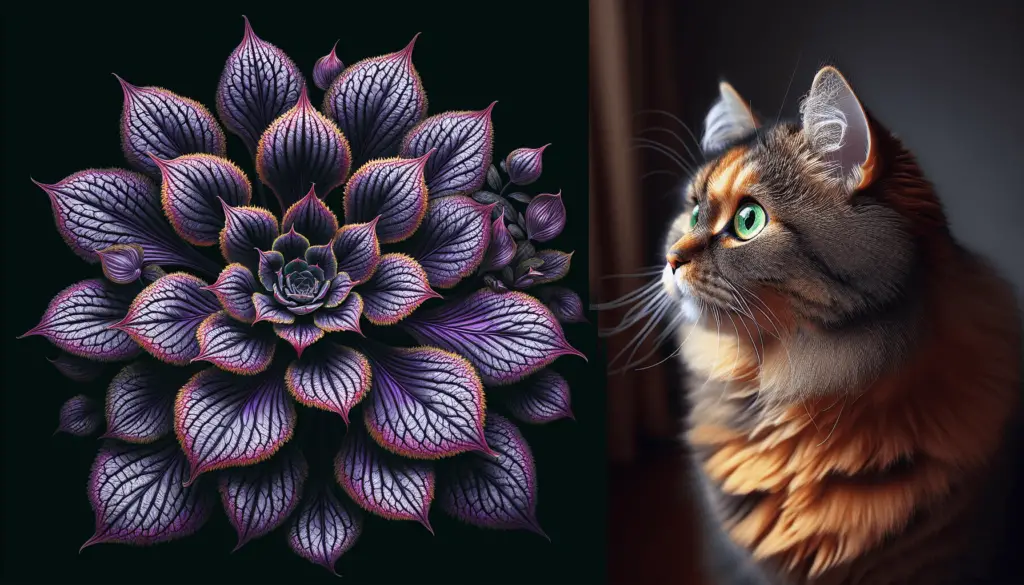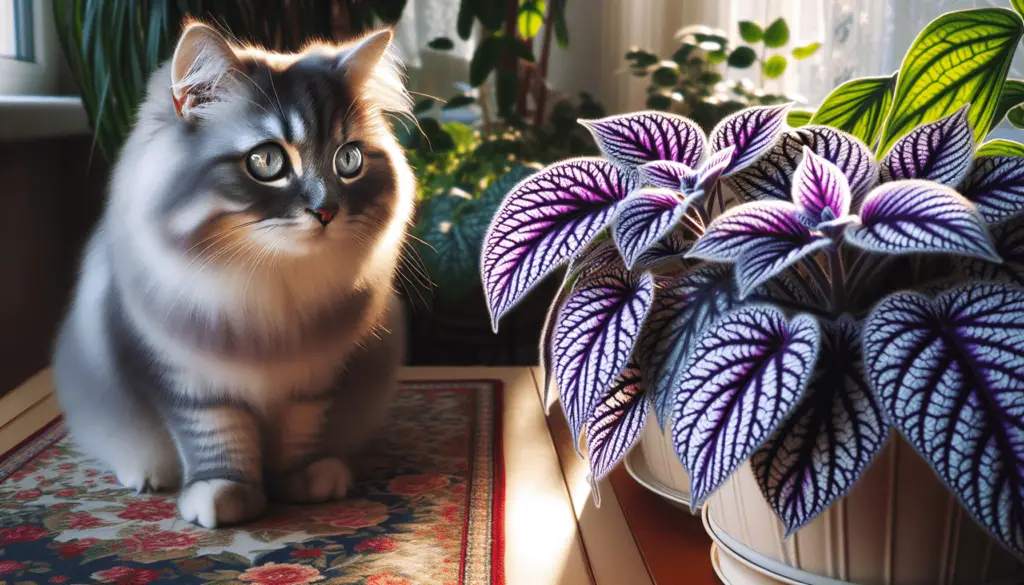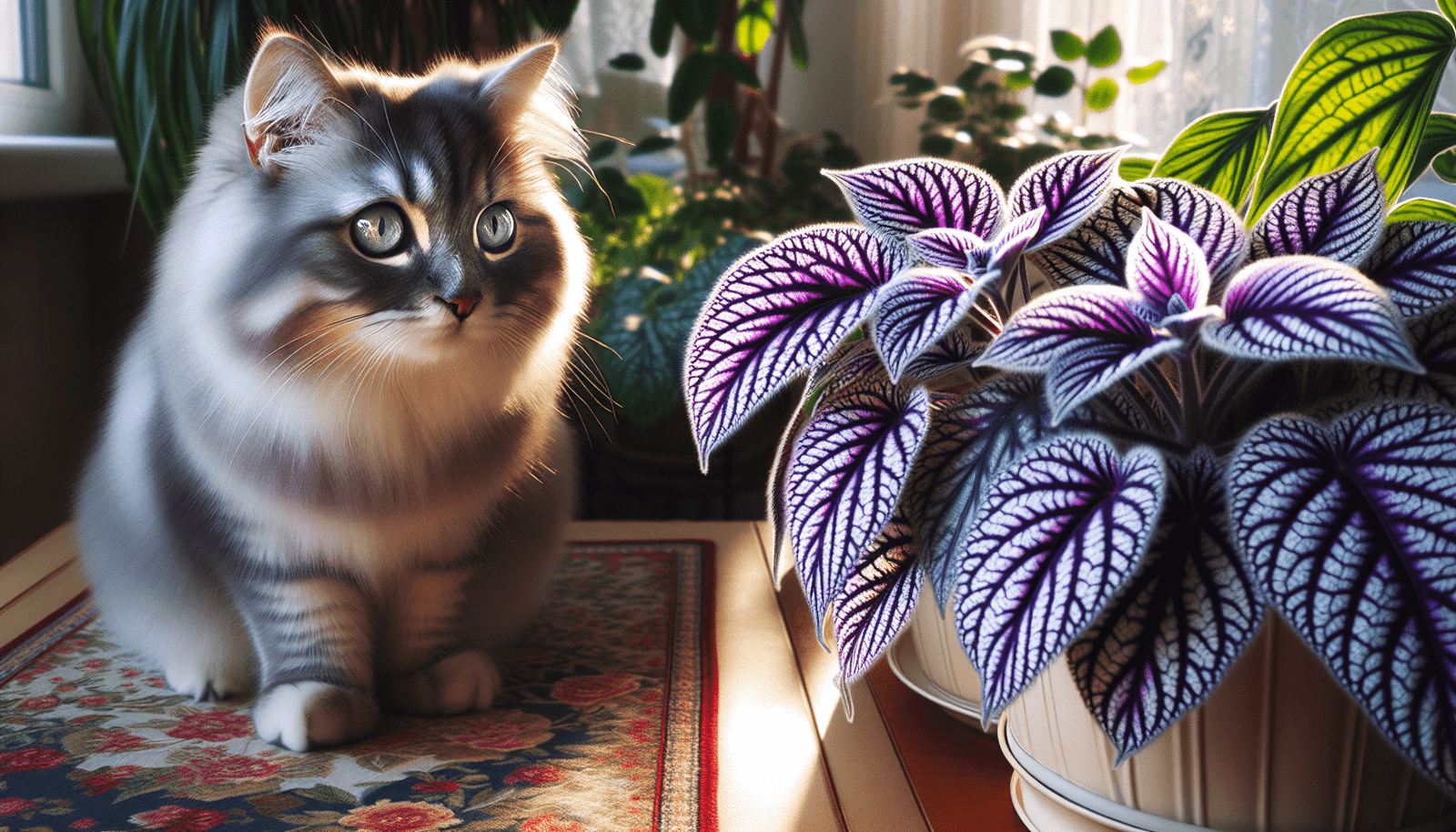Have you ever wondered if Persian Shield, the beautiful and vibrant plant, can pose a threat to your feline friend? In this article, we will explore whether Persian Shield is poisonous to cats, providing you with the information you need to ensure the safety of your beloved pet. While this plant may be visually striking and add a touch of elegance to your home, it is essential to understand the potential risks that it may present to your furry companion. Let’s delve into the topic and find out more about the safety of Persian Shield for your curious cat.

What is Persian Shield?
Persian Shield, scientifically known as Strobilanthes dyerianus, is a stunning and vibrant plant that is often used as an ornamental foliage plant for its striking leaves. Native to Myanmar (formerly Burma), this tropical plant features iridescent purple leaves with silver accents, making it a popular choice among garden enthusiasts and plant lovers. While Persian Shield may add a touch of elegance to your indoor or outdoor space, it is important to be aware of its potential toxicity to our feline friends.
Toxicity in Persian Shield
Types of toxins in Persian Shield
Persian Shield contains compounds called iridoid glycosides, which are primarily responsible for its potentially toxic effects on cats. When ingested by cats, these substances can cause adverse reactions in their bodies, leading to poisoning.
Symptoms of poisoning in cats
If your cat comes into contact with or ingests Persian Shield, it is crucial to be vigilant for any signs of poisoning. Common symptoms of Persian Shield poisoning in cats include:
- Vomiting
- Diarrhea
- Drooling
- Lack of appetite
- Lethargy
- Difficulty breathing
- Irregular heartbeat
Immediate actions to take
If you suspect that your cat has been poisoned by Persian Shield, it is important to take immediate action to ensure their safety and well-being. Here are the steps you should follow:
- Remove your cat from the area where they came into contact with or ingested Persian Shield.
- Contact your veterinarian or a 24-hour emergency animal clinic for guidance.
- Provide your veterinarian with detailed information about the situation and the symptoms your cat is experiencing.
- Follow any instructions provided by your veterinarian and seek professional medical assistance for your cat.
Preventing Exposure to Persian Shield
Keeping Persian Shield out of reach
To protect your cat from potential poisoning, it is crucial to keep Persian Shield plants out of their reach. Cats are known for their curiosity and tendency to explore their surroundings, so it is essential to place the plant in an area where your feline friend cannot access it. Consider using hanging planters, elevated shelves, or closed rooms where your cat does not have access.
Choosing pet-safe alternatives
Instead of exposing your cat to the potential hazards of Persian Shield, consider opting for pet-friendly alternatives. Several indoor plants are safe for cats and can provide a similar aesthetic appeal. Some popular cat-friendly plants include Spider Plants, Boston Ferns, Areca Palms, and African Violets. These alternatives offer a safe and appealing environment for both you and your feline companion.
Safe Alternatives to Persian Shield
If you are looking for plants that are both visually captivating and safe for your cat, consider the following alternatives:
- Spider Plant (Chlorophytum comosum): Known for its long, arched leaves with striped patterns of green and white, Spider Plants are non-toxic to cats and add a touch of elegance to any space.
- Boston Fern (Nephrolepis exaltata): With its lush, feathery fronds, the Boston Fern is not only safe for cats but also acts as a natural air purifier, improving the overall air quality in your home.
- Areca Palm (Dypsis lutescens): The Areca Palm, also known as the Butterfly Palm, features graceful, arching fronds and is completely non-toxic to cats, providing a safe and tropical atmosphere.
- African Violet (Saintpaulia): African Violets produce beautiful clusters of colorful flowers and are an excellent choice for cat owners since they do not pose any threat to feline health.
By choosing these pet-safe alternatives, you can create an inviting and visually appealing environment for yourself and your four-legged companion without putting their health at risk.

Understanding Cat Poisoning
Common cat toxins
It is important to remember that Persian Shield is not the only potential hazard for cats. Many common household items and plants can be toxic to our feline friends. Some common cat toxins include:
- Certain human medications: Over-the-counter and prescription medications can be harmful to cats, even in small amounts. Always keep medications safely stored away from your curious kitty’s reach.
- Household cleaners: Many household cleaners contain toxic chemicals that can be harmful if ingested by cats. Be cautious when using cleaning products and ensure they are properly stored when not in use.
- Human foods: Foods like chocolate, grapes, onions, and garlic can be toxic to cats. Avoid sharing your meals with your cat and be mindful of what they have access to in the kitchen.
- Certain houseplants: In addition to Persian Shield, various other houseplants can pose a risk to cats. Understanding which plants are toxic can help you create a safe environment for your feline companion.
Symptoms of poisoning in cats
Cat poisoning can result in a wide range of symptoms, depending on the toxin involved. Common signs of poisoning in cats include:
- Vomiting and diarrhea
- Drooling or excessive salivation
- Lethargy and weakness
- Difficulty breathing
- Seizures
- Irregular heartbeat
- Unexplained bleeding or bruising
If you suspect that your cat has been exposed to a toxic substance, it is important to act quickly and seek veterinary assistance.
Immediate actions to take
When faced with a potential poisoning situation, it is essential to take immediate action to protect your cat’s health. Here are some immediate steps you should follow:
- Remove your cat from the source of the toxin and isolate them in a safe, contained area.
- Do not attempt to induce vomiting unless directed by a veterinarian, as some substances can cause further damage when brought back up.
- Contact your veterinarian or a local animal poison control hotline for guidance. Provide them with detailed information about the potential toxin and your cat’s symptoms.
- Follow any instructions provided by the veterinary professional and seek medical assistance for your cat as soon as possible.
Remember, prompt action can greatly increase the chances of a positive outcome for your cat. If in doubt, always consult a professional.
Indoor Plants: Potential Risks to Cats
List of common toxic plants
In addition to Persian Shield, there are several other common indoor plants that can pose a threat to your cat’s well-being if ingested. Some of these toxic indoor plants include:
- Lily (Lilium): True lilies, such as Easter lilies and Tiger lilies, are highly toxic to cats and can cause severe kidney damage if ingested.
- Pothos (Epipremnum aureum): Pothos plants, also known as Devil’s Ivy, contain insoluble calcium oxalate crystals, which can cause oral irritation, drooling, and difficulty swallowing in cats.
- Dieffenbachia (Dieffenbachia spp.): Dieffenbachia plants, commonly known as Dumb Cane, can cause intense oral irritation, swelling, and difficulty breathing if chewed or ingested by cats.
- Sago Palm (Cycas revoluta): The Sago Palm contains toxins that are highly poisonous to cats. Even a small ingestion can lead to liver failure and death.
Non-toxic indoor plants for cat owners
Fortunately, there are numerous non-toxic indoor plants that you can safely incorporate into your home environment without risking your cat’s health. Here are some beautiful and safe alternatives:
- Calathea (Calathea spp.): Known for their stunning foliage patterns, Calathea plants are non-toxic to cats and can add vibrancy to any indoor space.
- African Violet (Saintpaulia): As mentioned earlier, African Violets are not only safe for cats but also produce lovely clusters of colorful flowers.
- Boston Fern (Nephrolepis exaltata): Apart from its air-purifying properties, the Boston Fern is safe for cats and can be an excellent addition to your indoor garden.
- Orchids (Orchidaceae): Orchids are elegant and visually appealing flowering plants that are non-toxic to cats, offering a touch of sophistication to your home decor.
By choosing these non-toxic alternatives, you can create a safe and visually pleasing indoor environment for both you and your beloved feline companion.
Keeping Your Cat Safe and Healthy
To ensure the well-being of your cat, it is important to adopt a proactive approach to their care. Here are some tips to keep your cat safe and healthy:
Regular veterinary check-ups
Schedule regular veterinary check-ups to monitor your cat’s overall health and address any potential medical issues promptly. Routine examinations, vaccinations, and preventive treatments can help prevent various diseases and keep your cat in optimal condition.
Creating a cat-friendly environment
Designate a safe and comfortable space for your cat within your home. Provide them with appropriate scratching posts, interactive toys, and cozy hiding spots to fulfill their natural instincts and keep them entertained. Creating a stimulating and enriching environment for your cat helps promote their physical and mental well-being.
Proper nutrition and hydration
Feed your cat a balanced and nutritious diet that meets their specific dietary needs. Provide fresh water daily and ensure that their feeding area is clean and easily accessible. Consult your veterinarian for guidance on the appropriate type and amount of food for your cat’s age, size, and health status.
Seeking Veterinary Assistance
Contacting your veterinarian
If you suspect that your cat has been exposed to a potentially harmful substance or is showing symptoms of poisoning, it is critical to contact your veterinarian immediately. They will provide you with the necessary guidance and instructions to ensure the health and safety of your furry friend.
Providing relevant information
When seeking veterinary assistance, be prepared to provide relevant information to assist the veterinarian in diagnosing and treating your cat effectively. Be ready to share details about the potential toxin, the symptoms your cat is experiencing, and the estimated time of exposure. This information will help your veterinarian make informed decisions and provide appropriate care to your cat.
Educating Cat Owners
Promoting awareness about toxic plants
Spread awareness about the potential dangers of toxic plants, including Persian Shield, to other cat owners. Educate friends, family, and fellow pet owners about the risks and precautions necessary to keep cats safe. By sharing information, you can help prevent accidents and protect cats from potential harm.
Sharing cat safety tips
Offer guidance and share cat safety tips with other cat owners. Inform them about common household hazards, toxic substances, and how to create a cat-friendly environment. Encourage open discussions about cat health and safety, fostering a community that prioritizes the well-being of feline companions.
Conclusion
While Persian Shield may be visually stunning, it is essential to recognize its potential toxicity to cats. By understanding the risks and taking necessary precautions, you can ensure the safety and well-being of your feline friend. Remember to keep Persian Shield out of reach, choose pet-safe alternatives, and be proactive in creating a cat-friendly environment. Regular veterinary check-ups, proper nutrition, and seeking prompt veterinary assistance when needed are crucial steps in keeping your cat safe and healthy. Educating yourself and others about potential hazards and sharing cat safety tips can further contribute to the well-being of our feline companions. By prioritizing the safety of our cats, we can create a harmonious and nurturing environment for our beloved pets.

